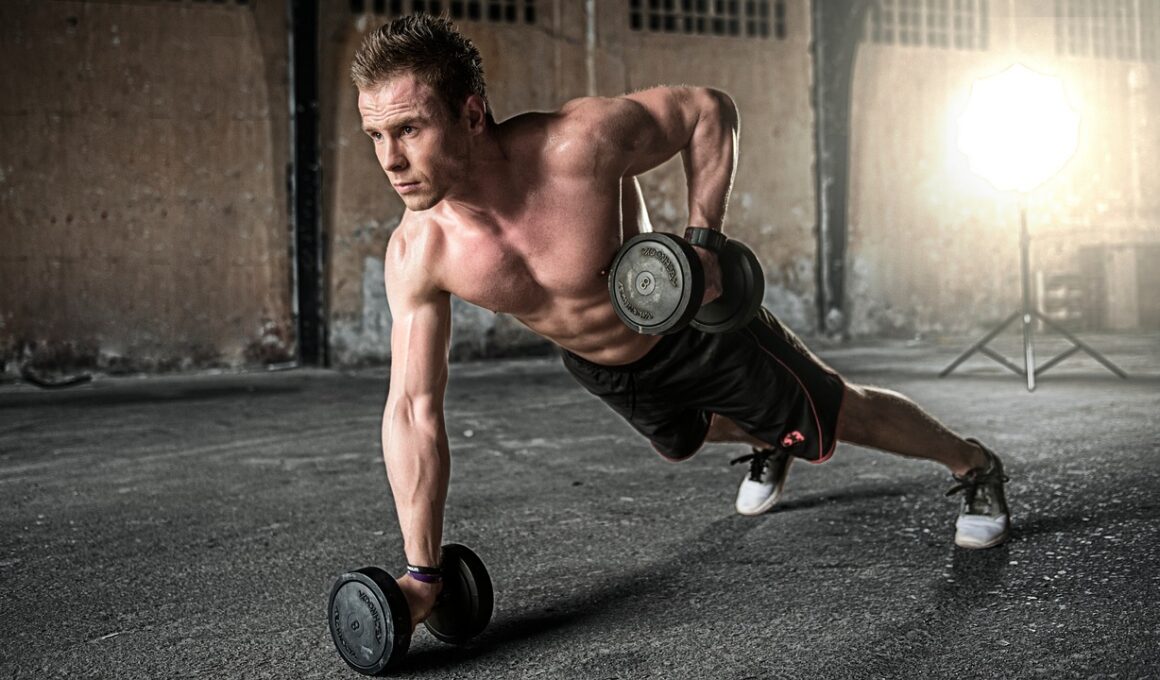Gym Workouts for Men to Improve Athletic Performance
To enhance athletic performance, men should focus on a variety of gym workouts that target strength, speed, endurance, and agility. These four components are crucial in improving overall athletic capabilities. Engaging in compound exercises such as squats, deadlifts, and bench presses will build strength. Incorporate Olympic lifts to increase power. To develop speed, include sprint drills and plyometric exercises. Agility training through ladder drills and cone drills will boost your reaction time and coordination. Moreover, integrating endurance workouts, like running or cycling at a steady pace, can elevate cardiovascular health. A balanced workout routine is essential to avoid burnout and maintain motivation, while improving athleticism effectively. Variety also prevents plateaus, thus ensuring consistent improvement. To further enhance training effects, consider partnering with a workout buddy who holds you accountable, encourages you during tough sets, and adds a social element to exercise. Lastly, always remember to listen to your body and adjust your routines accordingly, making sure to incorporate rest and recovery which are vital components of any successful training program. Training wisely will yield optimal results and improve your athletic performance in various sports.
Strength Training Variations
Strength training variations play a pivotal role in enhancing athletic performance. Men can benefit from incorporating both free weights and machines into their routines. Free weights, such as barbells and dumbbells, require the body to engage stabilizing muscles, promoting functional strength necessary for sports activities. Machines, in contrast, offer controlled motions which can help isolate specific muscle groups, allowing greater focus on weak areas. Include exercises like push-ups and pull-ups to develop upper body strength. To enhance lower body power, utilize variations of squats and lunges. As your strength progresses, consider adjusting weights and repetitions, ensuring you always challenge your body. In addition, explore different formats such as supersets, circuit training, or pyramid sets to continuously stimulate growth and adapt to high-intensity sports demands. Engaging in periodization can also optimize training outcomes by alternating between phases focusing on strength, power, and endurance. This method fosters both muscle gain and performance improvements effectively. Additionally, remember to warm up properly before each session and prioritize cool-down exercises to enhance recovery, ultimately allowing you to return to training ready to push your limits further.
Anaerobic training is equally vital for improving athletic performance. This type of exercise encompasses high-intensity activities that rely on the body’s reserves of energy, promoting strength and muscle-building without much cardiovascular focus. Incorporating short, explosive workouts like sprint intervals or hill sprints can build muscle and improve speed significantly. Additionally, men’s workouts can include circuit training to build strength while keeping the heart rate elevated. This method allows engagement of different muscle groups and enhances endurance simultaneously. Examples of effective circuit workouts might include kettlebell swings, burpees, and box jumps mixed with short rest periods. By engaging in anaerobic activities, athletes build more responsive and powerful muscles, crucial in competitive sports. As men prioritize anaerobic exercises, it’s essential to pair them with a recovery strategy that includes adequate hydration and nutrition, fostering muscle repair and growth. Consuming nutrient-dense post-workout meals with a balance of proteins and carbohydrates helps in replenishing energy and facilitating recovery. This strategic combination of anaerobic workouts with proper nutrition eventually contributes significantly to improved overall athletic performance, ensuring athletes can maintain their competitive edge over time.
Flexibility and Mobility Training
Flexibility and mobility training are often overlooked but are essential components for improving athletic performance. Men’s workouts should include stretching exercises that enhance muscle flexibility and joint range of motion. This practice assists in preventing injuries and improving overall mobility during athletic endeavors. Fundamental stretches targeting major muscle groups, such as hamstrings, quadriceps, and hip flexors, should be incorporated regularly into workout routines. Dynamic stretches, performed before workouts, can enhance performance by activating muscles and preparing them for more intensive activities. Yoga or Pilates can also be beneficial in building strength and flexibility simultaneously, enabling a well-rounded athletic ability. Incorporating foam rolling techniques helps alleviate tension and tightness in muscles, promoting recovery after intense training sessions. Mobility movements, like hip circles and thoracic spine rotations, should also be included to facilitate fluid movements during sports. Incorporating these exercises enables better technique execution, improved power output, and greater efficiency in athletic performance. Balancing strength and flexibility ultimately allows men to perform at optimal levels during competitions and day-to-day athletic activities, promoting longevity in their sports careers.
A healthy diet is equally crucial for men seeking to improve their athletic performance through gym workouts. Consuming a well-balanced diet rich in proteins, healthy fats, and carbohydrates fuels performance and supports recovery efforts substantially. Proteins are essential for muscle repair, while carbohydrates serve as the main energy source during workouts. Healthy fats offer sustained energy and support overall bodily functions. Focus on whole foods, such as lean meats, fish, legumes, whole grains, fruits, and vegetables, to provide necessary vitamins and minerals. Moreover, hydration cannot be overlooked; adequate water intake is essential throughout training and competitions to maintain performance levels and prevent fatigue. Experimenting with meal timing can be beneficial as well, such as consuming protein-rich snacks post-workout to optimize recovery further. Planning meals around workout schedules ensures necessary nutrients are available to enhance training results effectively. In addition, monitoring caloric intake relative to energy expenditure helps maintain an optimal weight for athletic performance. Thus, understanding the relationship between diet and training helps create a pathway to maximize outcomes in gym workouts focusing on athletic prowess.
Supplementation Strategies
For those committed to improving athletic performance, supplementation can serve as a beneficial addition to workouts. While focusing on a nutritious diet is paramount, certain supplements can foster enhanced energy levels, muscle growth, and recovery. Popular options among athletes include protein powders, creatine, and branched-chain amino acids (BCAAs). Protein powders serve as a convenient means of meeting protein intake goals, especially for those with busy lifestyles. Creatine is well-researched and proven to increase strength and muscle mass when combined with resistance training. BCAAs help reduce muscle soreness and promote faster recovery between workouts, allowing men to train harder and more frequently. However, it’s essential to research and choose high-quality products from reputable brands to ensure safety and efficacy. Consulting with a healthcare or nutrition professional beforehand can provide tailored strategies that align with specific fitness goals. Additionally, not all supplements are effective for everyone, and individual responses may vary based on personal goals and body types. Thus, it’s crucial to listen to one’s body and adjust intake accordingly, striking a balance between supplementation and a well-rounded diet.
In conclusion, gym workouts for men aimed at enhancing athletic performance rely on a multifaceted approach involving strength training, anaerobic conditioning, flexibility and mobility training, nutrition, and supplementation. Each of these elements plays an essential role in maximizing potential during training and improving results. Men who embark on this comprehensive fitness journey must remain consistent in their efforts while prioritizing recovery and nutrition. It’s also beneficial to adopt an enthusiastic attitude towards learning about new exercises, routines, and dietary practices. Coaching and guidance from experienced trainers can significantly enhance this journey, ensuring proper technique and workout efficacy. Moreover, setting realistic and achievable goals related to athletic performance can foster motivation and yield satisfying progress. Tracking one’s workouts and dietary intake provides insights into personal development and areas for improvement while celebrating milestones achieved. Ultimately, the dedication towards refining workout routines and enhancing overall well-being will contribute to a sustainable fitness lifestyle while improving performance across various athletic platforms. With commitment and proper planning, men can achieve remarkable results, enabling them to excel in their chosen sports endeavors.

